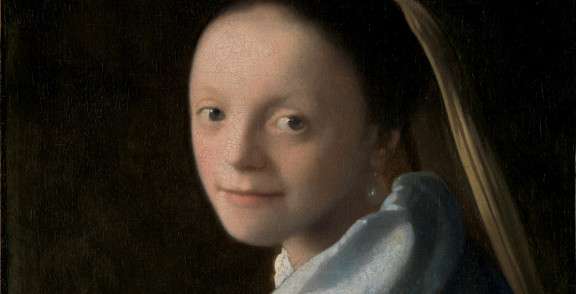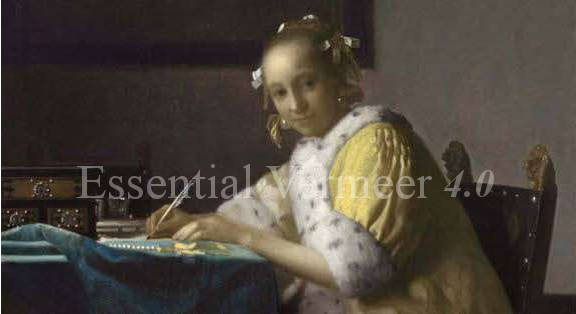Origin, History and Characteristics
(Smalte, smaltino, starch blue, cobalt glass)
Smalt is ground blue cobalt-containing glass. It was first described by Borghini in 1584. Cobalt oxide obtained was melted together with quartz and potash or added to molten glass. When poured into cold water, the blue melt disintegrated into particles which were then grounded. Several grades of smalt were made according to cobalt content and grain size. In European painting it was initially used as a substitute for expensive natural ultramarine, although it is much less bright. Smalt has been historically important as a pigment in painting, pottery, for surface decoration of other types of glass and ceramics, and other media (fig. 1). It is colored to a deep powder blue hue using cobalt ions derived from cobalt oxide. In the sixteenth century, the Erzgebirge mountains were mined for mineral ores of cobalt and antimony that were used to make the blue pigment smalt, a potash glass, as well as yellow pigments based on lead-antimony oxides.
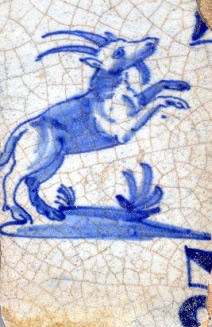 fig. 1
fig. 1
Ceramic tile painted with smalt pigment
As smalt is a glass, its particles are transparent, and its covering power as a pigment for fine painting is low. Therefore it must be coarsely ground for use as a pigment. When used in oil medium, it has a tendency to settle under the paint film (causing it to yellow in time) and streak down perpendicular surfaces. Smalt was frequently bound with a protein binding medium (usually parchment or animal skin glue) as stated in several contemporary treaties to prevent it from being altered by the yellowing of the oil film. The gelatinous nature of the glue medium keeps the particles suspended until the paint becomes dry. Although smalt is known to fade, the degree to which this occurs can vary even within the same painting.
"Our appreciation of the wide range of uses of smalt is hindered by its having deteriorated over time. The skies in paintings by the Venetian artist Paolo Veronese have turned greyish. The blue robe worn by the Virgin in Tintoretto’s Madonna of the Stars has lost its blue color and become brownish.Unfortunately, the smalt Rembrandt used has decayed and the paint has become a turbid brownish color; backgrounds and curtains in his paintings are now dingy looking, but must once have been quite blue."Barbara H. Berrie, "Mining for Color: New Blues, Yellows, and Translucent Paint," Early Science and Medicine 20, no. 4-6 (2015): 308-334, https://doi.org/10.1163/15733823-02046p02.
LOOKING OVER VERMEER'S SHOULDER
The complete book about Johannes Vermeer's and 17th-century fine-painting techniques and materials
by Jonathan Janson | 2020
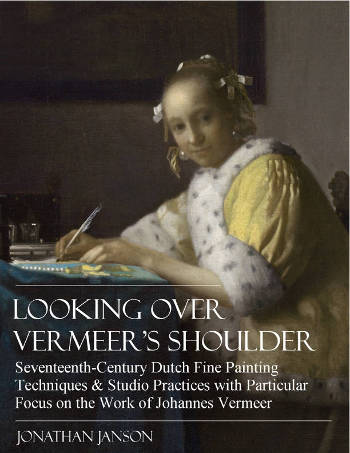
Enhanced by the author's dual expertise as both a seasoned painter and a renowned authority on Vermeer, Looking Over Vermeer's Shoulder offers an in-depth exploration of the artistic techniques and practices that elevated Vermeer to legendary status in the art world. The book meticulously delves into every aspect of 17th-century painting, from the initial canvas preparation to the details of underdrawing, underpainting, finishing touches, and glazing, as well as nuances in palette, brushwork, pigments, and compositional strategy. All of these facets are articulated in an accessible and lucid manner.
Furthermore, the book examines Vermeer's unique approach to various artistic elements and studio practices. These include his innovative use of the camera obscura, the intricacies of his studio setup, and his representation of his favorite motifs subjects, such as wall maps, floor tiles, and "pictures within pictures."
By observing closely the studio practices of Vermeer and his preeminent contemporaries, the reader will acquire a concrete understanding of 17th-century painting methods and materials and gain a fresh view of Vermeer's 35 masterworks, which reveal a seamless unity of craft and poetry.
 While the book is not structured as a step-by-step instructional guide, it serves as an invaluable resource for realist painters seeking to enhance their own craft. The technical insights offered are highly adaptable, offering a wealth of knowledge that can be applied to a broad range of figurative painting styles.
While the book is not structured as a step-by-step instructional guide, it serves as an invaluable resource for realist painters seeking to enhance their own craft. The technical insights offered are highly adaptable, offering a wealth of knowledge that can be applied to a broad range of figurative painting styles.

LOOKING OVER VERMEER'S SHOULDER
author: Jonathan Janson
date: 2020 (second edition)
pages: 294
illustrations: 200-plus illustrations and diagrams
formats: PDF
$29.95
CONTENTS
- Vermeer's Training, Technical Background & Ambitions
- An Overview of Vermeer’s Technical & Stylistic Evolution
- Fame, Originality & Subject Matte
- Reality or Illusion: Did Vermeer’s Interiors ever Exist?
- Color
- Composition
- Mimesi & Illusionism
- Perspective
- Camera Obscura Vision
- Light & Modeling
- Studio
- Four Essential Motifs in Vermeer’s Oeuvre
- Drapery
- Painting Flesh
- Canvas
- Grounding
- “Inventing,” or Underdrawing
- “Dead-Coloring,” or Underpainting
- “Working-up,” or Finishing
- Glazing
- Mediums, Binders & Varnishes
- Paint Application & Consistency
- Pigments, Paints & Palettes
- Brushes & Brushwork
Smalt was frequently used by painters in the blue skies and distant mountains. It was popular for its low cost and its manufacture became a specialty of the Dutch and Flemish in the seventeenth century. Smalt is a very good dryer and was admixed in small quantities to dry other slower drying pigments.
Smalt in Vermeer's Painting
In several early paintings by Vermeer smalt was found, but mostly as an admixture to other pigments in deep layers. The smalt found in Vermeer's paintings is very coarse grained. There is smalt in the lighter area of the wallsof A Maid Asleep (fig. 2) together with azurite, ocher, brown ocher and naturally the principal component, white-lead and in the underpainting of the blue area of the carpet. An upper area contains instead, azurite and natural ultramarine. Smalt may also be found in The Procuress in both the light white areas and as a component of the green paint with lead-tin yellow.
There is extensive use of smalt in Diana and her Companions in the brown undermodeling where it is bound in a protein medium, it is also in the flesh tones as well as in the thistle, the rock and the dog's white fur.
In a few of his earlier works Vermeer used small quantities of smalt to tone down the white areas of pure white instead of black which produces a sullen matt gray effect. The artist later used natural ultramarine for the same purposes in works such as the Young Woman with a Water Pitcher.
Vermeer seems to have abandoned smalt after the first few early works along with complex mixtures of five or more pigments.
- BOON, J. and OBERTHALER, E., "Mechanical Weakness and Chemical Reactivity Observed in the Paint Structure and Surface of 'The Art of Painting'" in Vermeer: Die Malkunst - Spurensicherung an einem Meisterwerk, exh. cat., Kunsthistorisches Museum, Vienna 2010, 235–53 and 328–35.
- CARYLE, Leslie A. "Beyond a Collection of Data: What We Can Learn from Documentary Sources on Artists' Materials and Techniques." In Historical Painting Techniques, Materials, and Studio Practice: Preprints of a Symposium, edited by Arie Wallert, Erma Hermens, and Marja Peek, 1-5. University of Leiden, the Netherlands, 26-29 June 1995.
- COSTARAS, Nicola. "A Study of the Materials and Techniques of Johannes Vermeer." In Vermeer Studies, edited by Ivan Gaskell and Michiel Jonker, Studies in the History of Art 55, Center for Advanced Study in the Visual Arts, Symposium Papers XXXIII. Washington: National Gallery of Art & New Haven: Yale University Press, 1998, 145–167.
- DELANEY, John K., Kathryn A. Dooley, Annelies van Loon, and Abbie Vandivere. “Mapping the Pigment Distribution of Vermeer’s Girl with a Pearl Earring.” Heritage Science 8, no. 4 (January 7, 2020). Accessed May 2, 2022.
- EASTAUGH, Nicholas, Valentine Walsh, Tracey Chaplin and Ruth Siddall. The Pigment Compendium 2017. Rev. ed. (e-version). London: The Pigmentum Project, 2016.
- FINK, Daniel A. "Vermeer's Use of the Camera Obscura: A Comparative Study." The Art Bulletin 53 (1971).
- GIEBE, Marlies. “Johannes Vermeers ‘Kupplerin’: Restaurierung Und Maltechnische Befunde.” In Uta Neidhardt and Marlies Giebe, eds., Johannes Vermeer: Bei der Kupplerin, 39–64. Exh. cat. Dresden: Michel Sandstein in association with Gemäldegalerie Alte Meister, Staatliche Kunstsammlungen, 2004.
- GIFFORD, E. Melanie, Anikó Bezur, Andrea Guidi di Bagno, and Lisha Deming Glinsman. “The Making of a Luxury Image: Van Aelst’s Painting Materials and Artistic Techniques.” In Tanya Paul, James Clifton, Arthur K. Wheelock Jr., and Julie Hochstrasser, Elegance and Refinement: The Still-Life Paintings of Willem van Aelst, 80–84. Exh. cat. New York: Skira Rizzoli, 2012.
- GIFFORD, M. "Painting Light: Recent Observations on Vermeer's Technique." In Vermeer Studies, edited by Ivan Gaskell and Michiel Jonker. Washington, D.C.: National Gallery of Art & New Haven and London: Yale University Press, 1998, 185–199.
- GIFFORD, E. Melanie, and Lisha Deming Glinsman. “Collective Style and Personal Manner: Materials and Techniques of High-Life 'Genre Painting'.” In Waiboer, Wheelock, and Ducos, Vermeer and the Masters of Genre Painting, 65–84, 270–74.
- GIFFORD, E. Melanie, Dina Anchin, Alexandra Libby, Marjorie E. Wieseman, Kathryn A. Dooley, Lisha Deming Glinsman, John K. Delaney. "First Steps in Vermeer’s Creative Process: New Findings from the National Gallery of Art," Journal of Historians of Netherlandish Art 14, no. 2 (Summer 2022).
- GIFFORD, E. Melanie. “Fine Painting and Eloquent Imprecision: Gabriel Metsu’s Painting Technique.” In Adriaan E. Waiboe, Gabriel Metsu, 154–79. New Haven: Yale University Press in association with the National Gallery of Art, 2010.
- GIFFORD, E. Melanie. “Lievens’ Technique: ‘Wonders in Smeared Paint, Varnishes and Oils.’” In Jan Lievens: A Dutch Master Rediscovered, edited by Arthur K. Wheelock Jr., 41–53. Exh. cat. New Haven: Yale University Press in association with the National Gallery of Art, 2008.
- GIFFORD, E. Melanie. “Material as Metaphor: Non-Conscious Thinking in Seventeenth Century Painting Practice.” In Studying Old Master Paintings: Technology and Practice, edited by Marika Spring, 165–72. London: Archetype in association with The National Gallery, 2011.
- GIFFORD, E. Melanie. “Painting Light: Recent Observations on Vermeer’s Technique.” In Vermeer Studies, edited by Gaskell and Jonker, 185–99.
- GROEN, Karin M., Inez D. van der Werf, Klaas Jan van den Berg, and Jaap J. Boon. "Scientific Examination of Vermeer's 'Girl with a Pearl Earring'." In Vermeer Studies, edited by Ivan Gaskell and Michiel Jonker. Washington, D.C.: National Gallery of Art & New Haven and London: Yale University Press, 1998, 169–183.
- HOMMES, M.H. van Eikema. "Verdigris Glazes in Historical Oil Paintings: Instructions and Techniques." In Discoloration in Renaissance and Baroque Oil Paintings. Instructions for Painters, Theoretical Concepts, and Scientific Data. Dissertation, 2002.
- HOWARD, Helen, David Peggie and Rachel Billinge. "Vermeer and Technique." National Gallery website. https://www.nationalgallery.org.uk/research/about-research/the-meaning-of-making/vermeer-and-technique
- JANSON, Jonathan. Looking Over Vermeer's Shoulder: Seventeenth-Century Painting Techniques and Studio Practices with Particular Focus on the Work of Johannes Vermeer, second edition. USA, 2020.
- KÜHN, Herman. "A Study of the Pigments and the Grounds used by Jan Vermeer." Reports and Studies in the History of Art. Washington: National Gallery of Art, 1968.
- LAURENZE-LANDSBERG, Claudia. “Neutron-Autoradiography of Two Paintings by Jan Vermeer in the Gemäldegalerie Berlin.” In Wolfgang Lefèvre, ed., Inside the Camera Obscura: Optics and Art under the Spell of the Projected Image, 213–25. Berlin: Max-Planck Institute for the History of Science, 2007.
- LEVY-HALM, Koos. “Where Did Vermeer Buy His Painting Materials? Theory and Practice.” In Gaskell and Jonker, Vermeer Studies, 137–43.
- LIBBY, Alexandra, E. Melanie Gifford, Dina Anchin, Marjorie E. Wieseman, Kathryn A. Dooley, Lisha Deming Glinsman, John K. Delaney. "Experimentation and Innovation in Vermeer’s Girl with the Red Hat: New Findings from the National Gallery of Art," Journal of Historians of Netherlandish Art 14, no. 2 (Summer 2022).
- LIEDTKE, Walter A., Richard C. Johnson, and Don H. Johnson. “Canvas Matches in Vermeer: A Case Study in the Computer Analysis of Fabric Supports.” Metropolitan Museum Journal 47 (2012): 101–8.
- LOON, Annelies van, Abbie Vandivere, John K. Delaney, Kathryn A. Dooley, Steven De Meyer, Frederik Vanmeert, Victor Gonzalez, Koen Janssens, Emilien Leonhardt, Ralph Haswell, Suzan de Groot, Paolo D’Imporzano and Gareth R. Davies. “Beauty is Skin Deep: The Skin Tones of Vermeer’s Girl with a Pearl Earring.” Heritage Science 7, no. 102 (December 11, 2019). Accessed May 2, 2022.
- LOON, Annelies van, Alessa A. Gambardella, Victor Gonzalez, Marine Cotte, Wout De Nolf, Katrien Keune, Emilien Leonhardt, Suzan de Groot, Art Ness Proaño Gaibor, and Abbie Vandivere. “Out of the Blue: Vermeer’s Use of Ultramarine in Girl with a Pearl Earring.” Heritage Science 8, no. 25 (February 28, 2020). Accessed May 2, 2022.
- MAHON, Dorothy, Silvia A. Centeno, Margaret Iacono, Federico Carό, Heike Stege and Andrea Obermeier. “Johannes Vermeer’s Mistress and Maid: New Discoveries Cast Light on Changes to the Composition and the Discoloration of Some Paint Passages.” Heritage Science 8, no. 30 (March 27, 2020). Accessed May 2, 2022.
- NEIDHART, Uta, and Marlies GIEBE, with essays by Albert Blankert, Chrisitne Klose, Johann Koller, Annalise Mayer-Meintsschel et al. Johannes Vermeer 'Bei der Kupplerin,' exh. cat. Dresden, 2004.
- PEETERS, Natasja. “The Painter’s Apprentice in Fifteenth and Sixteenth Century Antwerp: An Analysis of the Archival Sources.” Mélanges de l’École française de Rome: Italie et Méditerranée modernes et contemporaines, nos. 131–2 (2019), 221–27, https://doi.org/10.4000/mefrim.6461.
- POTTASCH, Carol. “Underdrawings in the Paintings of Frans van Mieris.” In Quentin Buvelot, Frans van Mieris 1635–1681, 62–68. Exh. cat. Zwolle: Waanders 2005.
- OBERTHALER, E., J. Boon, S. Stanek, and M. Griesser. "'The Art of Painting' by Johannes Vermeer. History of Treatments and Observations on the Present Condition." In Vermeer, Die Malkunst: Spurensicherung an einem Meisterwerk, exh. cat. Vienna: Kunsthistorisches Museum, 2010, 215–234 and 322–327. See especially illustrations 49 and 50.
- SHELDON, L., and N. Costaras. "Johannes Vermeer's 'Young Woman Seated at a Virginal'." The Burlington Magazine 148 (February 2006): 89–97.
- SIVEL, Valerie, Joris Dik, Paul Alkemade, Libby Sheldon, and Henny Zandbergen. “The Cloak of Young Woman Seated at a Virginal: Vermeer, or a Later Hand?” ArtMatters: Netherlands Technical Studies in Art 4 (2007): 90–96.
- SLUIJTER, Eric Jan. “Emulative Imitation among High-Life Genre Painters.” In Waiboer, Wheelock, and Ducos, Vermeer and the Masters of Genre Painting, 36–49.
- STEADMAN, Phillip. Vermeer's Camera: Uncovering the Truth behind the Masterpieces. Oxford: Oxford University Press, 2001.
- STOLS-WITLOX, Maartje. A Perfect Ground: Preparatory Layers for Oil Paintings, 1550–1900. London: Archetype Publications, 2017..
- VANDIVERE, Abbie, Annelies van Loon, Kathryn A. Dooley, Ralph Haswell, Robert G. Erdmann, Emilien Leonhardt, and John K. DELANEY. “Revealing the Painterly Technique beneath the Surface of Vermeer’s Girl with a Pearl Earring Using Macro- and Microscale Imaging.” Heritage Science 7, no. 64 (September 2, 2019). Accessed May 2, 2022.
- VANDIVERE, Abbie, Annelies van Loon, Tom Callewaert, Ralph Haswell, Art Ness Proaño Gaibor, Henk van Keulen, Emilien Leonhardt, and Joris Dik. “Fading into the Background: The Dark Space surrounding Vermeer’s Girl with a Pearl Earring.” Heritage Science 7, no. 69 (September 16, 2019). Accessed May 2, 2022.
- VANDIVERE, Abbie, ed., “The Girl in the Spotlight: A Technical Re-Examination of Vermeer’s Girl with a Pearl Earring.” Special Collection, Heritage Science 7–8 (2019–20). Accessed May 2, 2022.
- VANDIVERE, Abbie, Jørgen Wadum, and Emiliene Leonhardt. “The Girl in the Spotlight: Vermeer at Work, His Materials and Techniques in Girl with a Pearl Earring.” Heritage Science 8, no. 20 (March 2, 2020). Accessed May 2, 2022.
- VANDIVERE, Abbie. “The Technical (Re-)Examination of Vermeer’s Girl with a Pearl Earring.” Heritage Science 8, no. 26 (March 11, 2020). Accessed May 2, 2022.
- VERSLYPE, Ige. “The Restoration of ‘Woman in Blue Reading a Letter’ by Johannes Vermeer.” The Rijksmuseum Bulletin 60, no. 1 (2012): 2–19.
- WALD, Robert. “The Art of Painting: Observations on Approach and Technique.” In Sabine Haag, Elke Oberthaler, and Sabine Pénot, Vermeer, Die Malkunst: Spurensicherung an einem Meisterwerk, 312–27. Exh. cat. St. Pölten: Residenz in association with Kunsthistorisches Museum, Vienna, 2010.
- WALLERT, Arie. “The Materials and Methods of Michiel Sweerts’s Paintings.” In Jansen and Sutton, Michiel Sweerts, 37–47.
- WADUM, Jørgen, René Hoppenbrouwers, and Luuk Struick van der Loeff. Vermeer Illuminated: Conservation, Restoration and Research: A Report on the Restoration of the View of Delft and the Girl with a Pearl Earring by Johannes Vermeer. Wormer: V+K in association with the Royal Cabinet of Paintings Mauritshuis, The Hague, 1994.
- WADUM, Jørgen. "Contours of Vermeer." In Vermeer Studies. New Haven and London, 1998, 201–223.
- WHEELOCK, Arthur K., Jr. Vermeer and the Art of Painting. New Haven: Yale University Press, 1995.
- WIESEMAN, Marjorie E. “Acquisition or Inheritance? Material Goods in Paintings by Vermeer and His Contemporaries.” In Waiboer, Wheelock, and Ducos, Vermeer and the Masters of Genre Painting, 50–63.
- WIESEMAN, Marjorie E., Alexandra Libby, E. Melanie Gifford, Dina Anchin. "Vermeer’s Studio and the Girl with a Flute: New Findings from the National Gallery of Art," Journal of Historians of Netherlandish Art 14, no. 2 (Summer 2022).
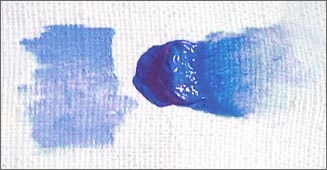
 fig. 1
Ceramic tile painted with smalt pigment
fig. 1
Ceramic tile painted with smalt pigment 
While the book is not structured as a step-by-step instructional guide, it serves as an invaluable resource for realist painters seeking to enhance their own craft. The technical insights offered are highly adaptable, offering a wealth of knowledge that can be applied to a broad range of figurative painting styles.
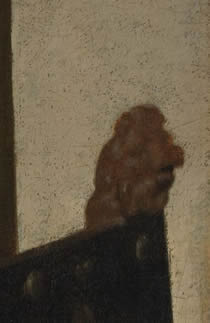 fig. 2 A Maid Asleep (detail)
fig. 2 A Maid Asleep (detail) 